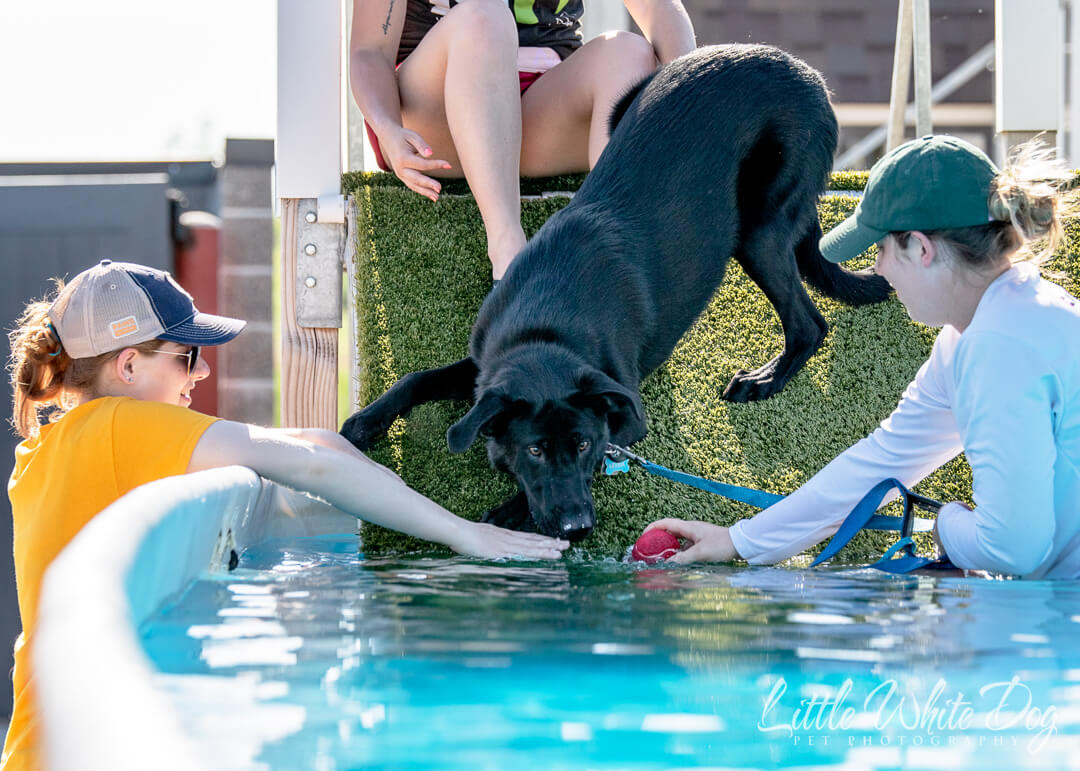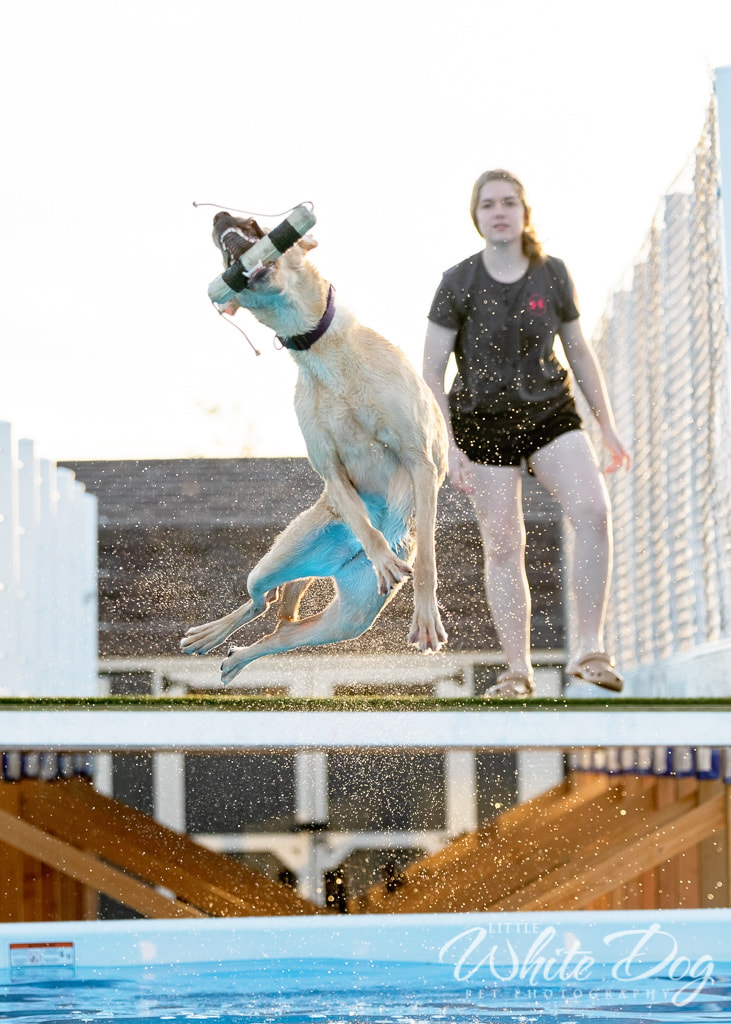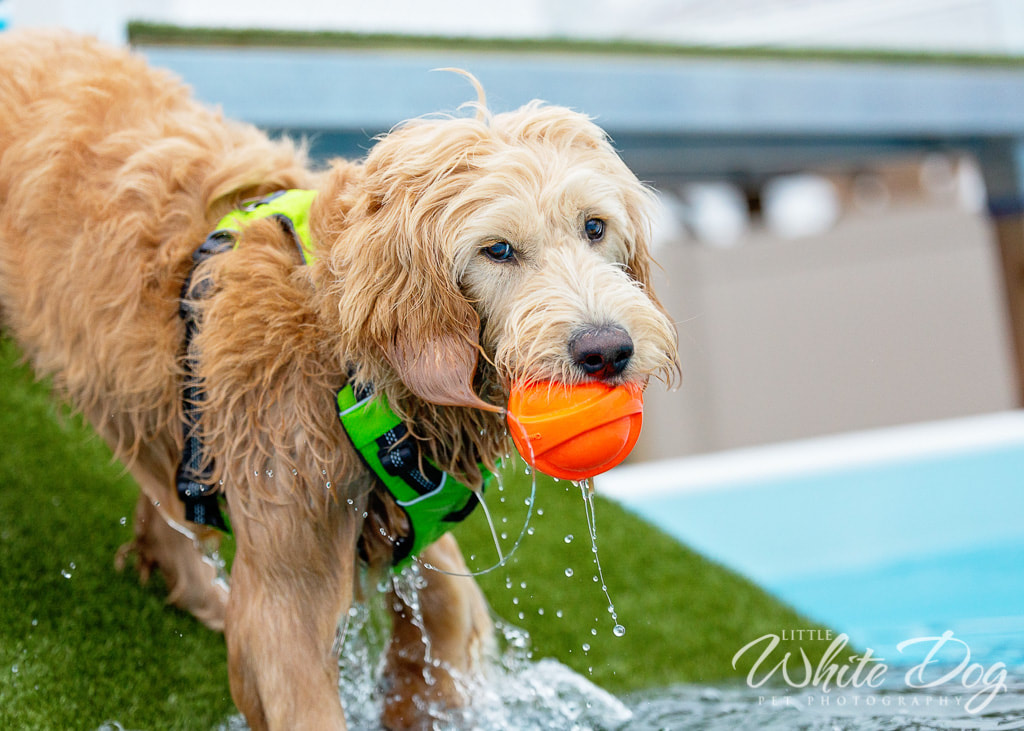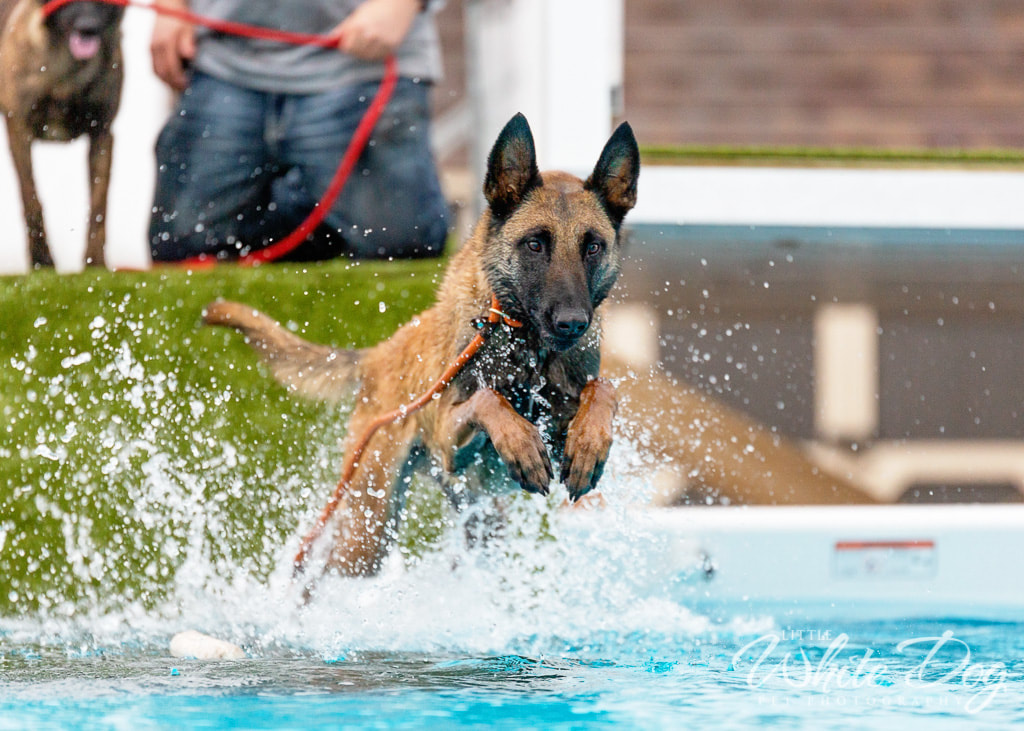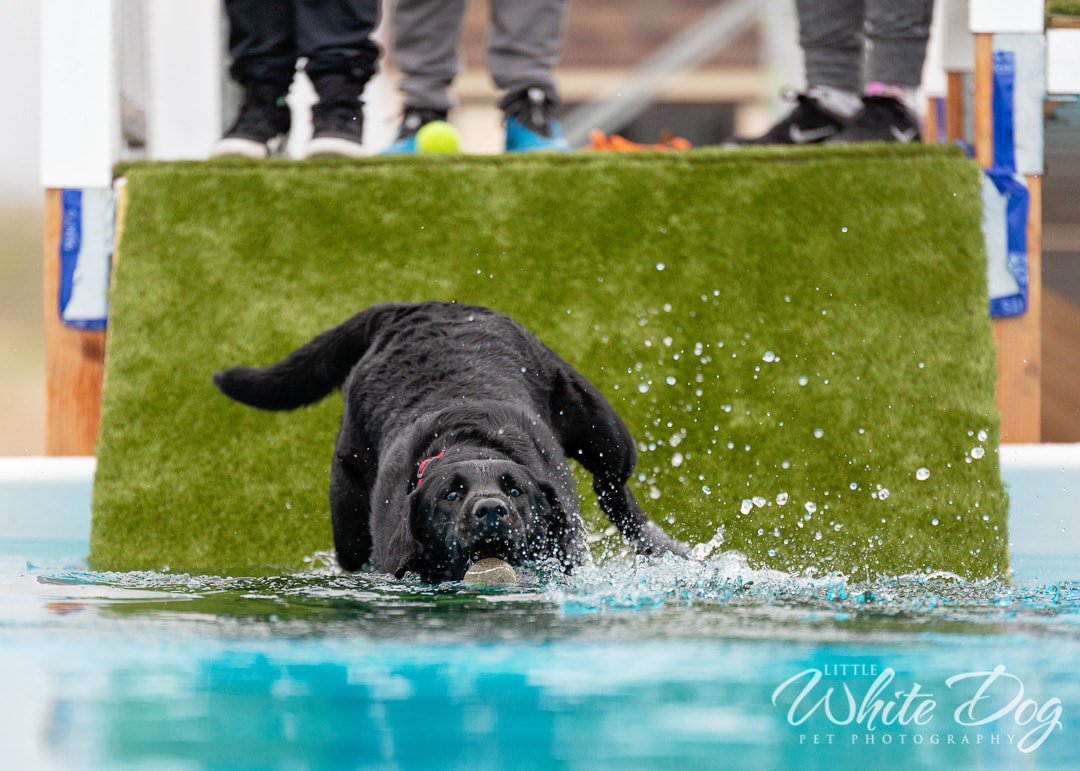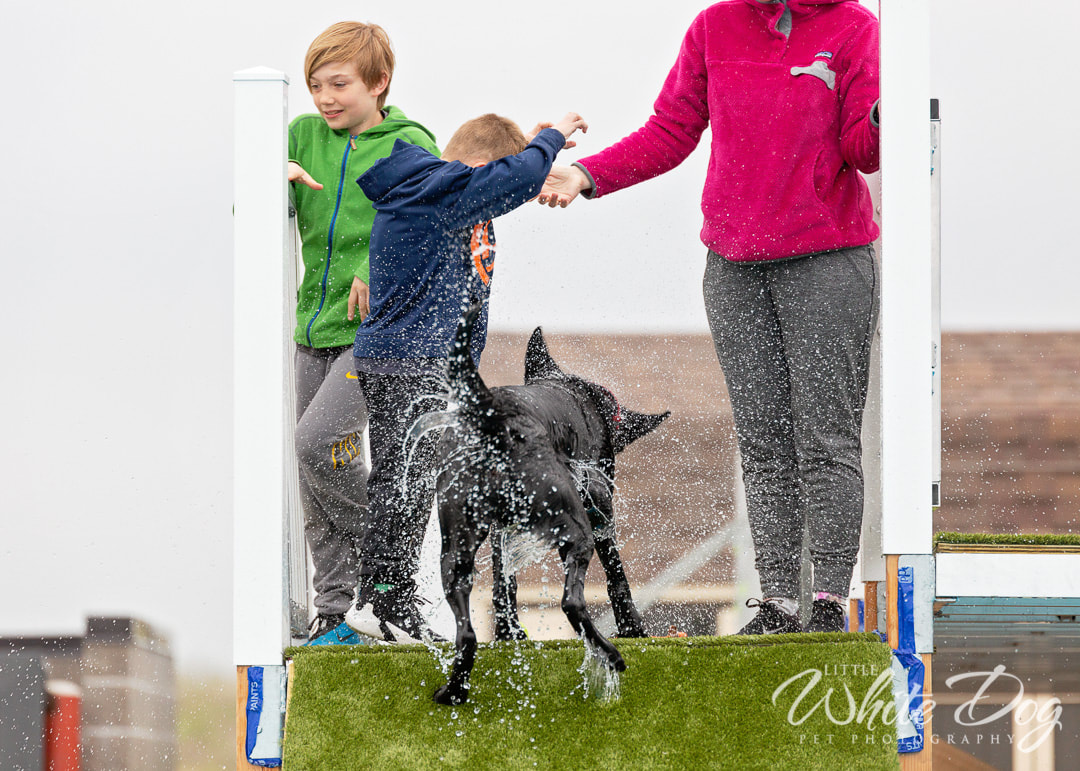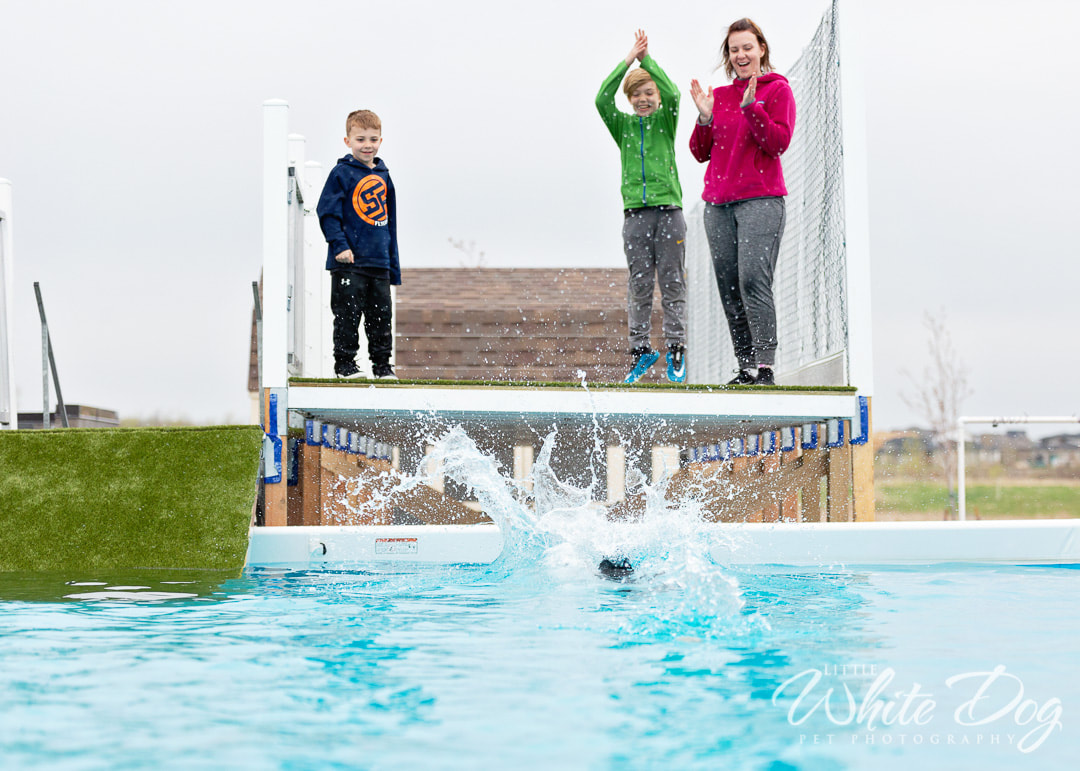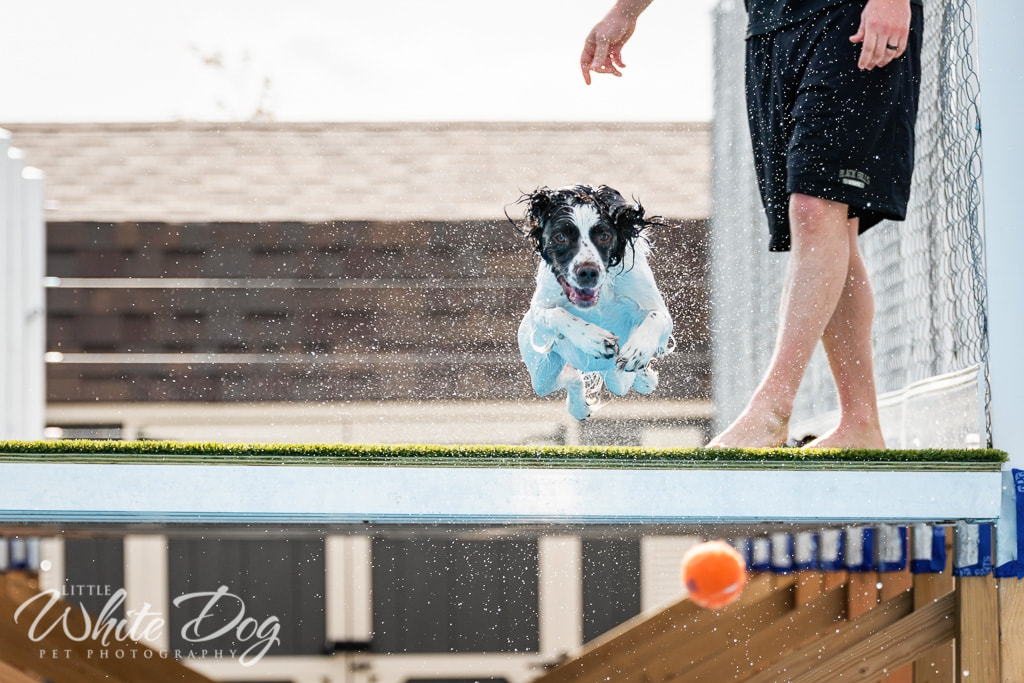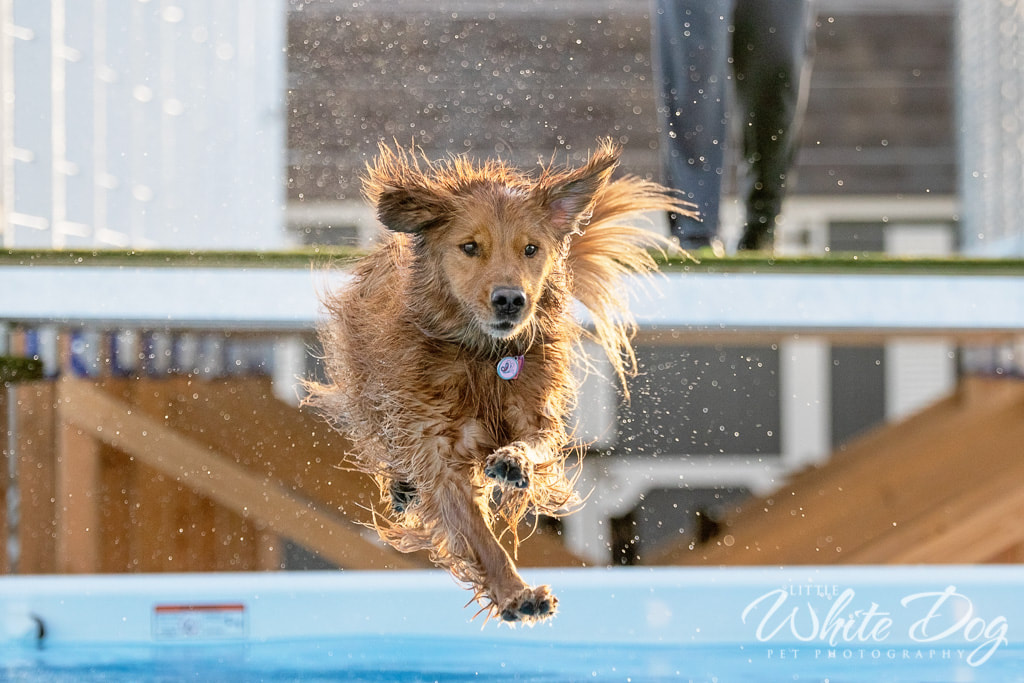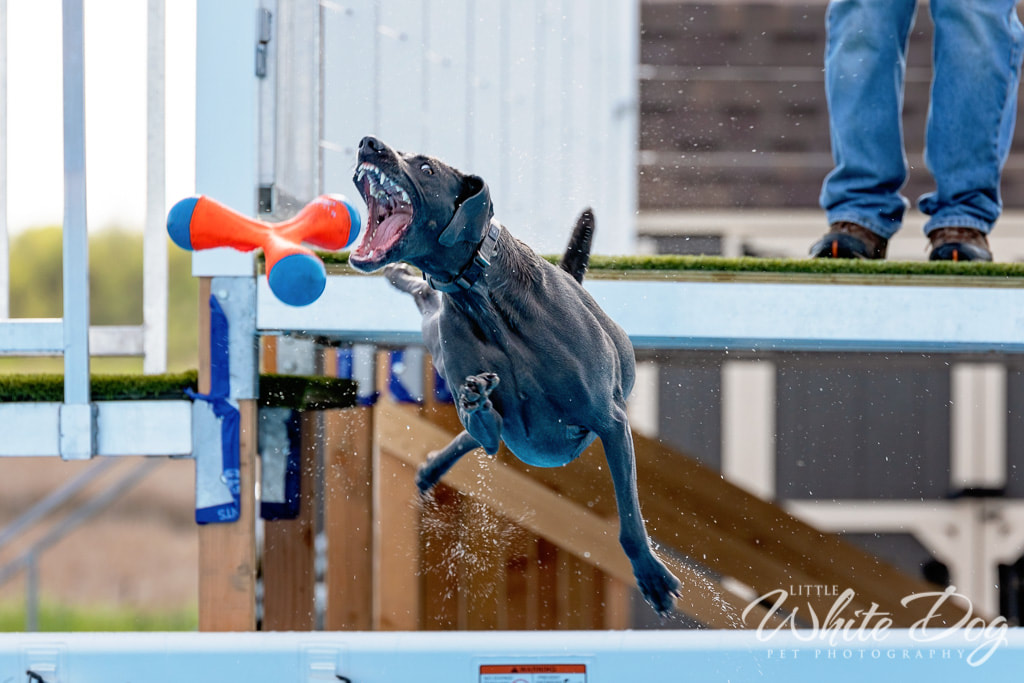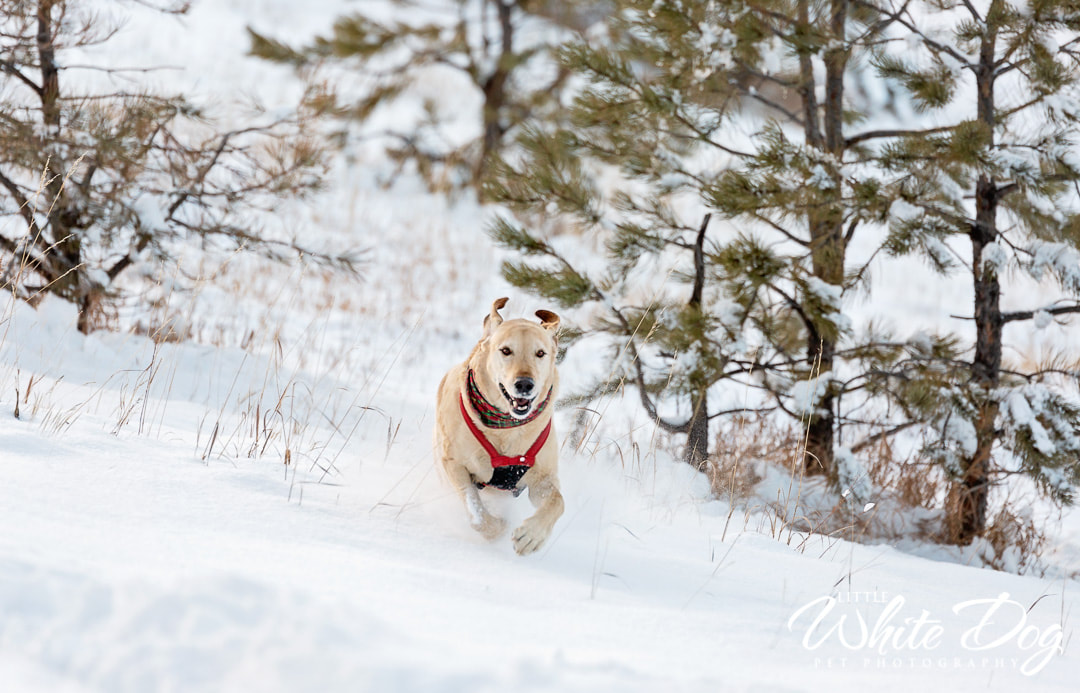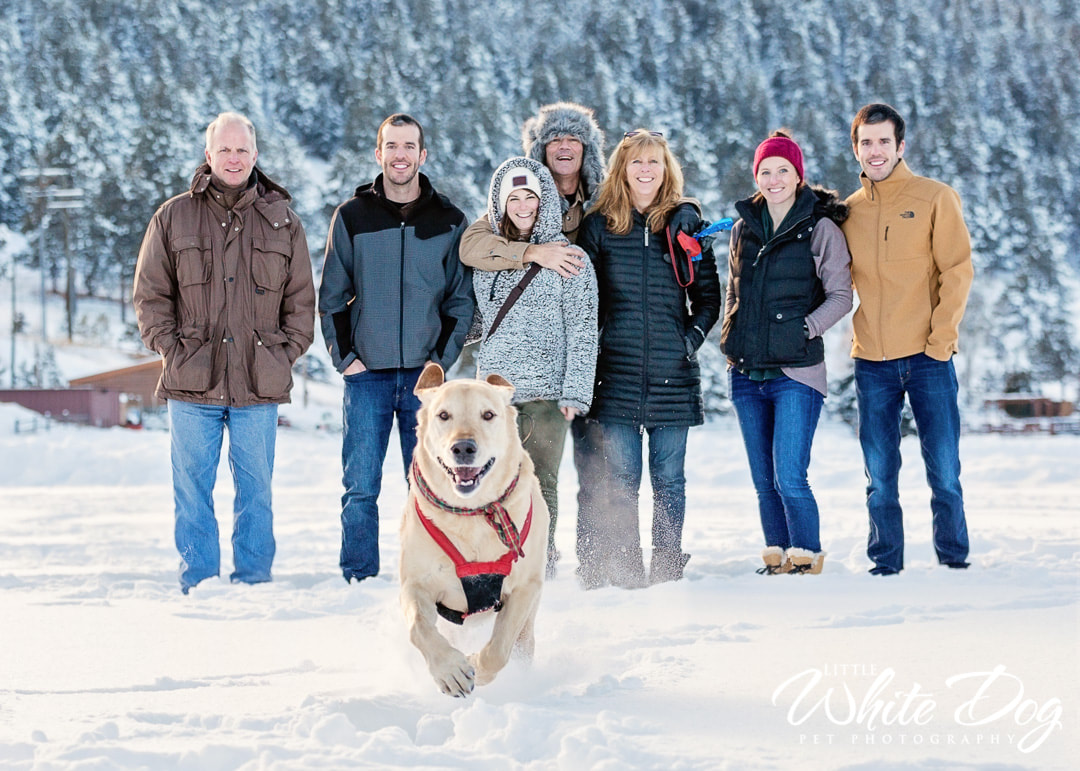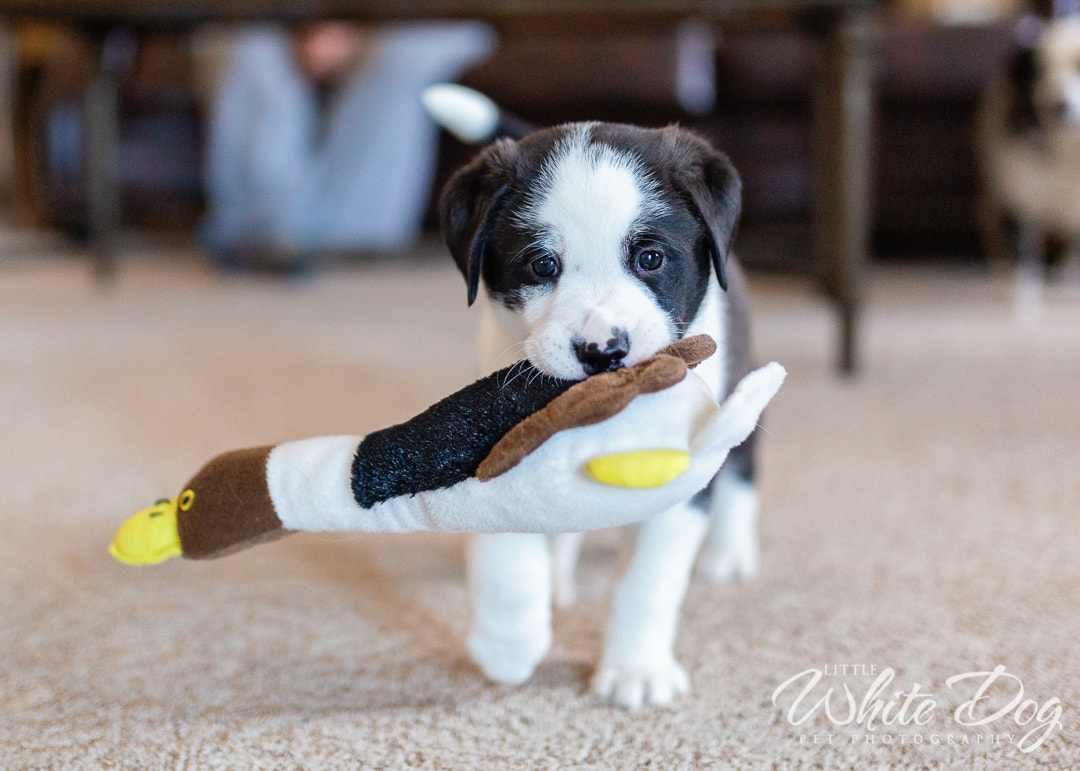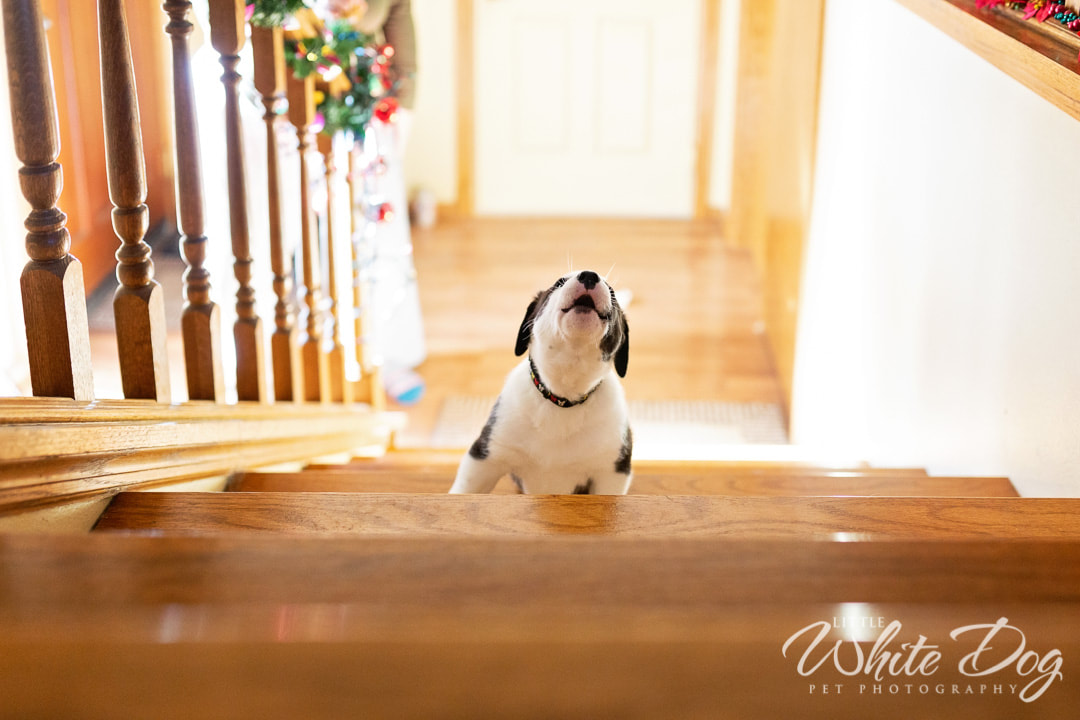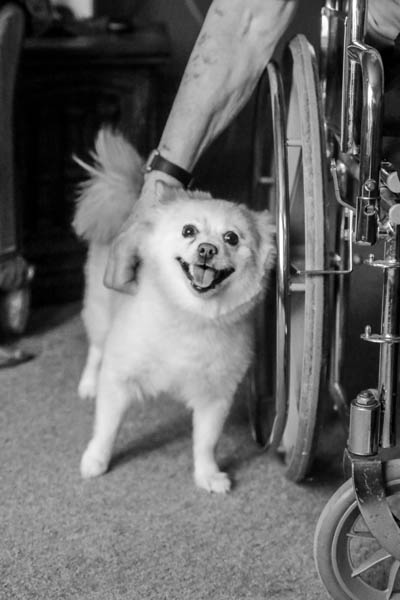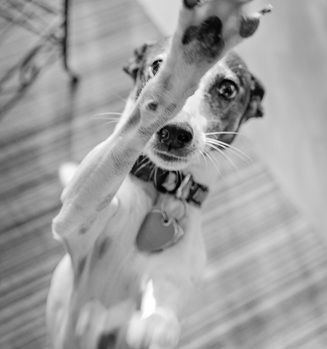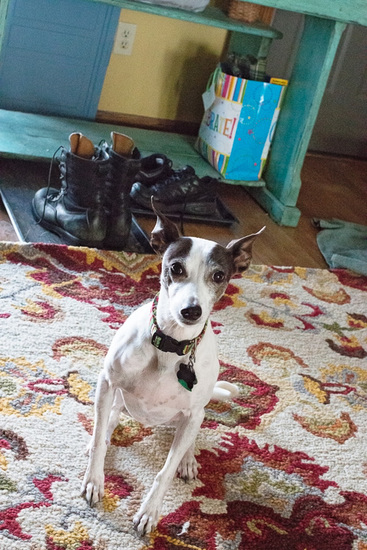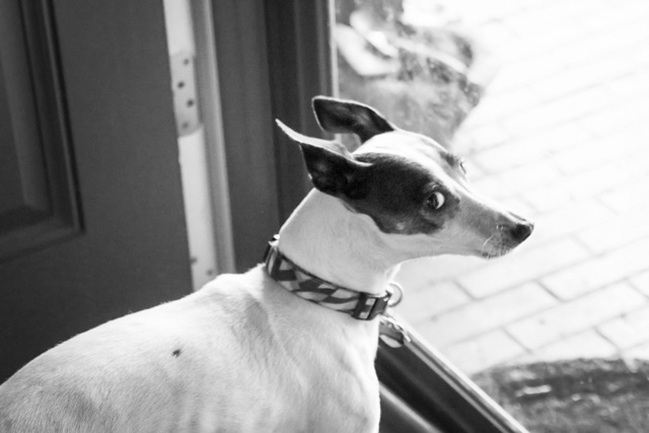|
Does your dog love the water? Looking for something fun, challenging, and (dare I say) cool? When summer hits and the temperature starts to rise dock diving might be just the thing for you and your dog. Dock diving is not a sport that you'll find in the Olympics (but, never say never). The idea is this... Your dog sits at the back of the dock and waits for you to give your command and throw his favorite toy out into the pool. When he hears the command he runs and dives off of the dock to catch his toy in mid air before it hits the water. The idea is to have the longest jump. It can be 2 feet or 30 feet, but all the dogs agree that no matter what, you're always a winner if you catch the toy. Henry, Max, and Linus are all beginners and they are very keen on making sure that their favorite toy doesn't get lost in this new game. Otis was a fast learner during his class. He loved the praise for simply getting in the water to leaping off the dock. It was all the same to him and he was eager to please his family. Then there is something we call style. And, guess what? They all have it (and they all own it!)... and it is soooo much fun to watch! If you think this might be a sport that you and your dog would like to do together, Paws Pet Resort now offers dock diving classes. Beginners can learn starting with the basics, and seasoned divers can utilize Open Jump days helping their handlers perfect their toss and getting in sync. If you just want to see if your dog might enjoy the sport, there are Try It Days available as well as one on one classes. Get out there and enjoy the summer with your dog. And, if you feel like you need to cool off (or if you're just feeling like a cool cat) you might give dock diving a try. ;O)
For your dogs safety (and your sanity), the most important thing you can teach your dog is to come when called. The last thing you want is for your dog to chase after something right into oncoming traffic or get into a situation that is not safe. The main components for any training are consistency and patience. Most people start by teaching their pet to sit and then to stay. Once your dog has these two down, you can start the most important lesson of all - "come." If you want to teach your dog something new, you need to make sure that you've got something that they want. Be ready to reward your pet with something they love and lots of praise; it can be treats, toys, or whatever makes them happiest. Make it easy for them at first. When teaching them to sit, as soon as their little booty hits the floor, reward them! You can make them sit before everything that they do. Ask them to sit before you put their food bowl down, before you give them a toy, or before you put their leash on, etc. Once they've got the hang of it move on to "stay." When they stay for 3 seconds, reward them! Gradually wait a little longer for each "stay" before you reward them. I might be wrong, but I've always felt that "stay" and "come" work hand in hand once you start moving away from your dog during these training sessions teaching them to stay. When you are able to walk a little ways away while your dog holds his stay, you can give your "come" command. After the second try they will usually be more than willing to run to you for their treat. After you've worked with your dog for a while and you feel they really understand the "stay" command, you need to take things to a higher level. (If your dog has a favorite treat, you'll want to use them for this command and no other. You want to make sure that your dog will come to you no matter what the circumstances might be.) Call your dog a few times throughout the day when you are not actively training. Make sure that you are prepared to reward them as soon as they get to you and praise them like crazy. You'll want to start off indoors while in the same room. At first make sure there are no distractions by anyone or anything. Once they come each time they are called, try calling them when they are playing or otherwise distracted. After a few days of success, try calling them from a different room. You will eventually end up in the yard with them, then possibly off leash somewhere safe. Remember that practice makes perfect. ;O) The one thing that can put a kink in your training is if you ever call your dog with a frustrated tone or scold them once they get to you. (I was so guilty of this with Hermes... like every time he ran out the door straight to the neighbor's compost pile. ick!) They need to know without a doubt that you will be happy when they get to you so try not to let them down. When strong-willed Hermes was dining at his private buffet, asking if he wanted a treat never worked because he knew that the treat was not going to top what he was chewing on at that time. The only thing that worked with him was bringing out the leash and asking if he wanted to go for a walk. He would then come to me so I could put the leash on him and I'd take him on his walk... (straight home, darn dog). *Although I do not post things that I don't agree with (without saying so that is), I need to stress that I am not a dog trainer. Information that I give to you in posts like this one are a compilation of information from others in dog related industries as well as research from books I've read and the internet. My blog posts are designed to give you enough information so that you can research on your own when you think the subject might be something that you and your dog can benefit from. When it comes to training I highly recommend seeking out a dog trainer. You can learn a lot about your dog while they in turn learn great skills. It will be a wonderful bonding experience for the two of you, too. ;O)
Is there a new puppy in your family? Congratulations! There are usually a lot of new puppies delivered by Santa and his helpers so I thought I'd do a post about what you might expect from your new little family friend in the next couple of months. Most puppies leave their mom for new homes at around 8 weeks. After getting use to their new family and starting the basics of house training, there are some big changes coming for these puppies between 12 and 16 weeks that you might notice. Around 12 weeks, puppies tend to have better control of their bladder (YAY!) If you stick to a schedule most puppies can be fully house trained by the time they are 4 to 5 months old. Just keep taking your puppy out first thing when they wake up in the morning (and after each of the many naps they like to take), after every meal, and after playtime as well. As a general rule of thumb when leaving your puppy for work or errands, take the number of months your puppy is in age and add a one to it. This is the maximum number of hours that a puppy should be expected to hold it. (Can you picture them crossing those chubby little legs?!) By 12 weeks, puppies start teething. You might notice more biting and chewing, redder gums, and you might even find a baby tooth laying around. Be sure your puppy has safe things to chew on during this time and make sure that there is nothing that they can get into that could hurt them like electrical cords, house plants, shoes that they can tear up, or socks that they can swallow (trust me, this happens all the time). Puppies grow fast between 4 and 6 months and tend to look like miniature versions of their adult self. Small breeds will be nearly finished growing at 6 months where larger breeds will be about half their adult size. Puppies are adorable, but between 3 and 6 months your puppy might start testing the boundaries (or pushing your buttons, ehem). They might not respond to the training that you have previously accomplished or they might start chewing on things they aren't suppose to chew on (simply because they can). You can lessen these tendencies by making sure your puppy has plenty of exercise and working on basic training. The exercise will tire them physically and the training will tire them mentally. The combination can do wonders for your pup. At around 4 months old, your puppy might show signs of being afraid. This is normal as they experience new things. Loud noises, for instance might frighten them. Try not to overwhelm your puppy. If you notice that they are afraid, like maybe when you bring out the vacuum, do not "reward" them by cuddling or you will be reinforcing their fear. Simply ignore the behavior and calmly remove them from the situation. Training and socialization are the best things that you can do for your puppy. From about 8 weeks until 6 months is the time that your puppy is prime for learning to be the best dog that they can be. Enrolling in a quality puppy class is a win-win for everyone, both human and canine. They will learn socialization skills, along with basic commands, walking on a leash, and manners. You want to let them be a dog because that's what they are, but you also want to make sure that they know how to treat you, your guests (both human and canine), and your home. Classes with a qualified trainer will not only show you how to work with and train your dog, but they will help you understand your dog better. Now... after writing this I think I need to go find a refresher course in doggie manners for this dog mom. Hermes is a great dog and I don't want him to fall short because I didn't keep up my part of the bargain. ;O) By the way, this little guy is named Scuttle and he will be looking for his permanent home in 3 weeks! *Although I do not post things that I don't agree with (without saying so that is), I need to stress that I am not a dog trainer. Information that I give to you in posts like this one are a compilation of information from others in dog related industries as well as research from books I've read and the internet. My blog posts are designed to give you information so that you can research on your own when you think the subject might be something that you and your dog can benefit from.
The Little White Dog product line grew by two. The first was the Acrylic Album Set and this second is this beautiful Folio Box! This box is sooooo impressive! Folio Boxes are custom made with whatever you'd like etched into the top. This can be a name, a quote, a design, you name it. The box holds ten of your favorite 8x10 images printed on Fuji Silk archival paper and mounted on ultra thick ridged board substrate. If you purchase the Print Collection from our products then you will also receive digital images of your choice on a matching USB. There are over 60 fabrics to choose from to give your box a unique look. You can choose one for the entire box or mix and match them for the perfect pairing. As I sat trying to decide which of my sessions to create this sample box with, I looked over and saw 4 marble shaped eyes staring at me. (Why are they always staring??) Well, the decision was made. Hermes and Dash needed to be the stars of this one. ;O) I've made some changes to my product line and I have some exciting news about sessions as well! First, let's talk digitals... :O) So many people want digital negatives these days. Some people want them for scrapbooking, some for printing their own wall art, and some want them for social media. There are a lot of things that go into a photographer's decision to sell or not sell digital negatives. For me, the point of creating images and artwork for the home is so we can look at them on a daily basis without having to do a thing. They bring us joy, they comfort us, and they bring back fond memories. How many people do you know who have a CD of their wedding that sits in a desk drawer? The answer for me is "too many." A lot of thought, time, and money went into creating those images (for both the client and the photographer). I know that I have videos of my kids when they were young that were taken and then never looked at (unless you count viewing it on the back of the recorder at the time I took them). I recorded them so that I could look back at them when my boys were grown and relive the memories. Well, how many of you have VHS tapes, or even micro cassettes of video that you can not look at because there is nothing to view them with? Even the CD that most have of their wedding is no longer viewable on a standard computer because most companies have done away with the CD drive. I feel very strongly that we need to print images so that we have something that does not require a device to view them with. Images that we can share with several generations. From the photographer's point of view, digital negatives are the most vulnerable product they can provide to a client. They need to protect their art by insuring that it is not poorly represented by a lower quality print from Walmart or canvas from Costco. (This is the sole reason that a lot of photographers do not offer digital negatives on their product list.) If you're the client and willing to take the time and effort that is required to hire a photographer, then you should be able to enjoy the images from that session every day. Having printed images is the best way to ensure that you can. Having said all that, I totally understand the reasons behind wanting to have digital negatives. In response, this is what I've done... First, I need for you to know that every session comes with free discreetly watermarked social media files to share. I've always provided these files and there is never a charge for them. If sharing your images on Facebook, Instagram, or through email is what you're looking for, then you are good to go. For those who want digital negatives to print on their own, I have developed a few digital negative groupings. Additionally, I now have two beautiful new products and have created packages with them that also include the negatives. (I'm anxiously waiting for my samples to arrive and will share as soon as I have them!) With these new products, I know that you will enjoy your images every day from the first moment you receive them (no matter when you decide to print from your digital negatives). It's a win-win! ;O) Now for the other fun news...
There is no longer a separate session fee when booking! Now, a retainer fee will be charged to hold your session date and time, but that retainer will become a product credit that can be used during the ordering session! (For those who have already booked a fall or winter session, don't worry, this will apply to you as well.) I hope you survived the shock of waking up to the first 3" of winter yesterday! I have to admit I thought the leaves sticking up from all the white stuff was quite pretty. Hermes and Dash thought otherwise. ;O) For the past year I've been a small part of a program that very few people know about. It's called AniMeals on Wheels. Most people are familiar with the Meals on Wheels program; they provide meals to those who for one reason or another cannot get out of the house or cannot cook for themselves. When it was noted that some of the Meals on Wheels recipients were sharing their limited food and resources with their pets, AniMeals took things one step further by helping to provide for those pets. AniMeals' mission is: To keep pets healthy and with their humans. AniMeals on Wheels is part of a nationwide program funded partially by Meals on Wheels America, and local donations. It is run by volunteers and provides pet food, litter, most veterinarian expenses, some grooming costs, and boarding when necessary. So many of these people aren't able to leave their homes very often, so the companionship that they share with their pet is almost tangible when you talk to them. They each have a story to tell . . . "I've had her since she was a puppy" . . . "I got him when my wife died" . . . "She found me when I needed her the most." Their stories are heartwarming, heartbreaking and inspiring all at once. These pet owners will tell you how much they love their pets, and it's pretty obvious that these pets love them right back. If you think that you might like to be a volunteer for Sioux Falls AniMeals on Wheels, please give them a call or shoot them an email. Volunteer positions range from delivering food and supplies, to walking dogs, to providing transportation for pets as well as other opportunities. AniMeals is located in the Active Generations building in Sioux Falls and you can talk with Samantha or Penny at 605-333-3302. If you'd rather email, you can do so at animeals@activegen.org. This is where I say . . . give your pet a hug. ;O)
"I would love to have great pictures like those, but my dog has to be on a leash." This is what I hear most when I talk to my clients for the first time. They love the images that they see in the gallery, but assume that their session images could never look like those because their dog has to be on a leash when outdoors. Here's a little secret . . . 98% of the images on my site were taken with the dog on a leash and his owner at the other end of it. Can you tell from the gallery images that the owner was standing there, sometimes right next to the dog? I myself, don't think any dog should be off a leash unless they are in their own fenced in yard where they are safe from cars, other dogs or anything else that might be a danger to them. Why risk it? The last thing anyone wants is to see a pet hurt when it could have been prevented. (And, that my friends is as political as I get.) While there are images that, in my opinion, need that leash to stay as part of the story, most of the time it needs to be edited out for esthetic reasons. Now, let me say right now that Photoshop is not something that you do to an image. It's not a magic wand that corrects an image instantaneously. Photoshop is a software used by artists for any number of projects. For photographers, it's an editing tool. When starting out, Photoshop is not simple and it is not easy, but with practice AND patience one can learn the skills necessary to meet their needs. For pet images it is wonderful for editing out eye boogers, slobber, . . . and leashes. Here's the truth of it all . . . When you and your pet join me at a pet session, your pet will pretty much run the show. I'm sorry, but that's just how it is. I've never had a pet respond to, "Ok Lucy, you come sit over here facing this way, and why don't you have your tail going this direction so everything is nice and balanced in the frame." I also can't say, "Oh wait, can you move that leash out of the way," because if I do they are already on to the next thing (translation: squirrel ). So, we walk around with them a bit and lead them in the direction we want them to go. And, pretty soon it happens . . . the pet that you know and love comes out to play (even on a leash! ) We always have so much fun and you know what? We get those shots. We get the shots of your pet and all that you love about them . . . and then I edit out the leash. :O) Here are a few before and afters of editing and leash removal. When sessions are held in a studio the photographer has control over everything from backgrounds, to lighting, to the posing of his subject. There is some amazing stuff that can be done in a studio. When pet photographers are doing an on-location shoot or an outdoor session they have control over . . . well, very little if none of that.
There are questions that every photographer asks themselves before clicking the shutter. They might start with something like: What do I want my viewer to feel when they see this image and how could I evoke that feeling? From there they might ask: Would this image be best zoomed in on one thing or zoomed out including the surrounding elements? Do I want to include the bright lighting that is coming from behind or would the image have more emotion silhouetted? When getting ready to click the shutter on my camera, one of the first things I look at is the background. I can't say to a dog, "Ok, could you please turn slightly to the left so I can get those concrete blocks out of the background?" No, but there are some things I can do to help make the image a better one. I can move myself and my camera so that the blocks are no longer in view (and hope the animal doesn't come to investigate why I'm moving), or I can adjust my camera settings so that the background takes on a more painterly effect making the blocks less noticeable (again, working quickly as not to lose the attention of my subject). Here is an example for this week's Project 52: Questions • In the first image there is a lot of clutter in the background that I was not able to crop out of the scene when I crouched down closer to my subject's level. (And . . . Hermes is about to jump out of his skin in anticipation of the treat that was in my hand. sheesh) • In the second image I moved 2 steps up onto the stairs that were behind me to change the angle of the shot (and to be a little further from Hermes so that he might stay put.) It's better, but it's a little busy with that carpet. We can see it's a dog, but the carpet is fighting for attention. • To take care of all that busy-ness I adjusted my camera settings so that the viewer is drawn straight to Hermes' face. (Just look at those adorable eyes.) I encourage you to try different angles when taking pictures of your own, especially when taking them with your phone. Just tip your phone a little up or down or even side to side. I think you might surprise yourself. :O)
This week you can follow the project ring and see the thought process of other photographers when trying to get the perfect shot. Head over to Boston pet photographer, Blue Amrich Studio to start the round. Be sure to click on the link at the end of each blog post to continue back around the circle. Enjoy your weekend! Street photography has been around almost as long as cameras have. Street photographers capture the true feeling and spirit of places and people through this documentary style of photography. Public places are free game to photographers and they do not have to have permission to take someone's picture. On top of that, the photographer owns the rights to these images. Done right, these images are brilliant in their artistry and I am a huge fan. Just like street photographers, portrait photographers own the legal copyright to the images that they produce and that photographer can use those images for whatever purpose he sees fit in order to help his business. He might use the images for marketing brochures, advertising, booths, shows, contests, etc. A photographer is an artist and he owns the rights to the art that he produces. It's as simple as that. I am all for art and I totally agree that the images produced by photographers should belong to the photographer. That artist's blood, sweat and tears go into those images and you have no idea how many hours are spent on a single photo session. A photographer is extremely picky about so many aspects of an image starting from the first camera setting to the placement and opacity of their watermark when revealing those images to the client. They want to make sure that they offer their clients something that they will cherish and be proud to display; at the same time, they are creating for their clients a piece of art that represents their own personal style and artistry.
This is one reason why I think it is only right to ask permission of a client before using a photo from their session for promotional purposes. None of us sees ourself the way others do. My feeling is that if the person in the photo is not comfortable with everyone seeing it, then it has no business being shown to anyone else. Images taken by a photographer for a client are for the client first and foremost. If that client is comfortable with the photographer using their image for his business then that's a bonus for the photographer. If a photographer asks you if he or she can use one of your session images, it's because she is very proud of it and thinks it represents her business perfectly. (Remember, photographers are picky people). If you are not comfortable with your picture being out there, then just say so. If you are, or even if you are on the fence, trust your photographer when she thinks that others will see your photo as the beautiful image that it is.
Who hasn’t yelled (at least once), “STOP IT!” when their dog just won’t stop barking? We tend to let it slip sometimes when we have heard enough of our furry family member making his presence known at the front door or the back fence. Hermes will bark at every human, animal, or leaf that is in view of the front door, back door or across the field. He’s not picky. If you have a barker, it wont do you any good to try and stop him with loud commands. however, if you want to try and control the barking, then here is one exercise that might work for you and your pet . . . As soon as your dog starts barking, calmly, but sternly say “Enough” and then get up and walk towards him with a small treat until the treat is within inches of his nose. Make soothing clicking noises as you do this to get his attention. When you have his attention, don’t give him the treat, but palm it in your hand and say “Good boy” a few times luring him away from the thing he was barking at. When he is away from the situation and stops barking this is when you can give him the treat. You have lured him away by signaling for him to stop (“Enough”), created a situation in which he did stop barking (luring him away with the treat), and then rewarded him for being quiet (giving him the treat). It sounds easy I know, but it’s a little harder than it appears so don’t give up. If you continue in this manner each time your dog barks, it will become familiar to him and you will see progress. Lure him away with a treat; then when he stops barking, give him the treat. Start small when you first embark on these training sessions. Don’t start when he’s out of control, barking like mad at the man who’s walking across the field with three dogs all pulling on their leashes. Instead, you want to start when he’s a bit less agitated. If you can foresee a situation ahead of time that will cause your dog to bark, this is best as you can be ready to say "Enough" before your dog is past the point of no return. You can also have a friend walk by or even knock at the door while you lure your dog away with a treat. You might have to go all the way up to your dog and hold the treat right smack in his face to get his attention, but that’s ok. The main thing is that you have to set up your routine and stick to it . . . He barks; you say “Enough” and lure him with a treat. After he’s quiet for a few seconds (make this time longer as you progress) give him the treat. Eventually, when your dog hears you say “Enough” he will coming trotting up to you on his own to get the treat. It is important to remember that to get a dog to stop barking is not as easy as teaching him to sit or stay. It’s much harder for a dog to stop doing something that is natural for him. Barking for a dog is linked to emotion and physiological arousal just as laughing, squealing and yelling is for kids. Who doesn’t remember a time in their childhood when a parent or teacher said to “Stop” and there was just no stopping the giggles that escaped no matter how hard you pressed your hand over your mouth? Now, picture your dog with his paw over his muzzle. Yep, makes a little more sense now doesn’t it? :O) [A lot of the dog behavior wisdom that you might find on this blog, I credit to books I’ve read by Patricia B. McConnell, Ph.D. The exercise I've just described is from one of her books entitled, The Other End of the Leash. Hermes and I will work on this and hopefully we will come to an understanding . . . I hope.] |
Quoted...I can't really get them to say "cheese," but I can almost always make them smile. -Kelly Categories
All
|
© 2014-2024 Little White Dog Pet Photography. All rights reserved.
Feel free to share images with your friends, but please do not crop or edit photos. (Some of the more sensitive pets feel it makes their tushie look big. )
Feel free to share images with your friends, but please do not crop or edit photos. (Some of the more sensitive pets feel it makes their tushie look big. )

